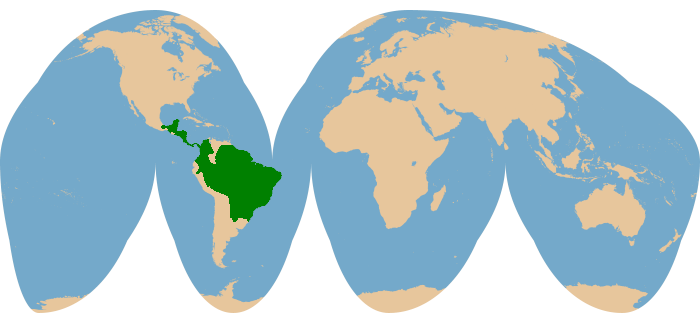Kingdom: |
Animalia Chordata Mammalia Artiodactyla Suiformes Tayassuidae Tayassu |
Common name:
Scientific name:
Other names:
|
White-lipped peccary
Tayassu pecari
Le pécari à lèvres blanches, le pécari aux babines
blanches, le pécari à barbe blanche, Weißbartpekari,
Bisamschwein, el chancho cariblanco, Tayasú tanyihka ti, Pecari labiado,
Queixo branco, Queixada, Tayasú tiragua, Tagnicate,
Tâchycâtí, Senso, Marina, Pingo, Witlippeccarie, Jagilla,
tayasu citam, baquira, pécari, and pecarí
|
Physical Characteristics
-
Head and body length: 90-139 cm
- Shoulder height: 40-60 cm
- Tail length: 3-6 cm
- Adult weight: 25-40 kg
- Shoulder height: 40-60 cm
White-lipped peccaries are dark brown or blackish in color. The coat is bristly, with the hairs running down the spine growing longer than the sides and forming an crest which is raised when the peccary becomes excited. The body is rounded and barrel-like, and the legs are long and slender. The face is long and ends with a pig-like nasal disc. Like the rest of the body, the head is dark brown, which makes the white markings surrounding the mouth and lower jaw stand out conspicuously.
-
Similar species
- The collared peccary (Tajacu pecari) and Chacoan peccary (Catagonus wagneri) are both found in regions occupied by white-lipped peccaries, but both species are grizzled grey in color, with a light "collar" around the neck and no white lip markings.
Reproduction and Development
-
Gestation period: 156-162 days
- Litter size: 2, sometimes 1 or 3.
- Weaning: By 6 months.
- Sexual maturity: Between 1 and 2 years of age.
- Life span: Up to 13 years.
- Litter size: 2, sometimes 1 or 3.
Mating times are highly variable depending on location (and food availability), but most peccaries in most regions appear to have a breeding season. Babies weigh just over 1kg at birth, and are reddish brown in color with a darker strip along the spine. Juveniles turn a lighter brown before darkening to the adult coloration after one year of age.
Ecology and Behavior
-
Family group: Very large herds of 20-300 animals of both sexes.
- Diet: Fruits, nuts and seeds (especially palm nuts), vegetation, and small amounts of animal matter.
- Main Predators: Jaguar and puma, potentially boa constrictors.
- Diet: Fruits, nuts and seeds (especially palm nuts), vegetation, and small amounts of animal matter.
Habitat and Distribution

Conservation Status
-
IUCN Red List: Near-threatened (2009).
- CITES Listing: Appendix II (2009).
- Threats: Habitat loss and overhunting by humans.
- CITES Listing: Appendix II (2009).





